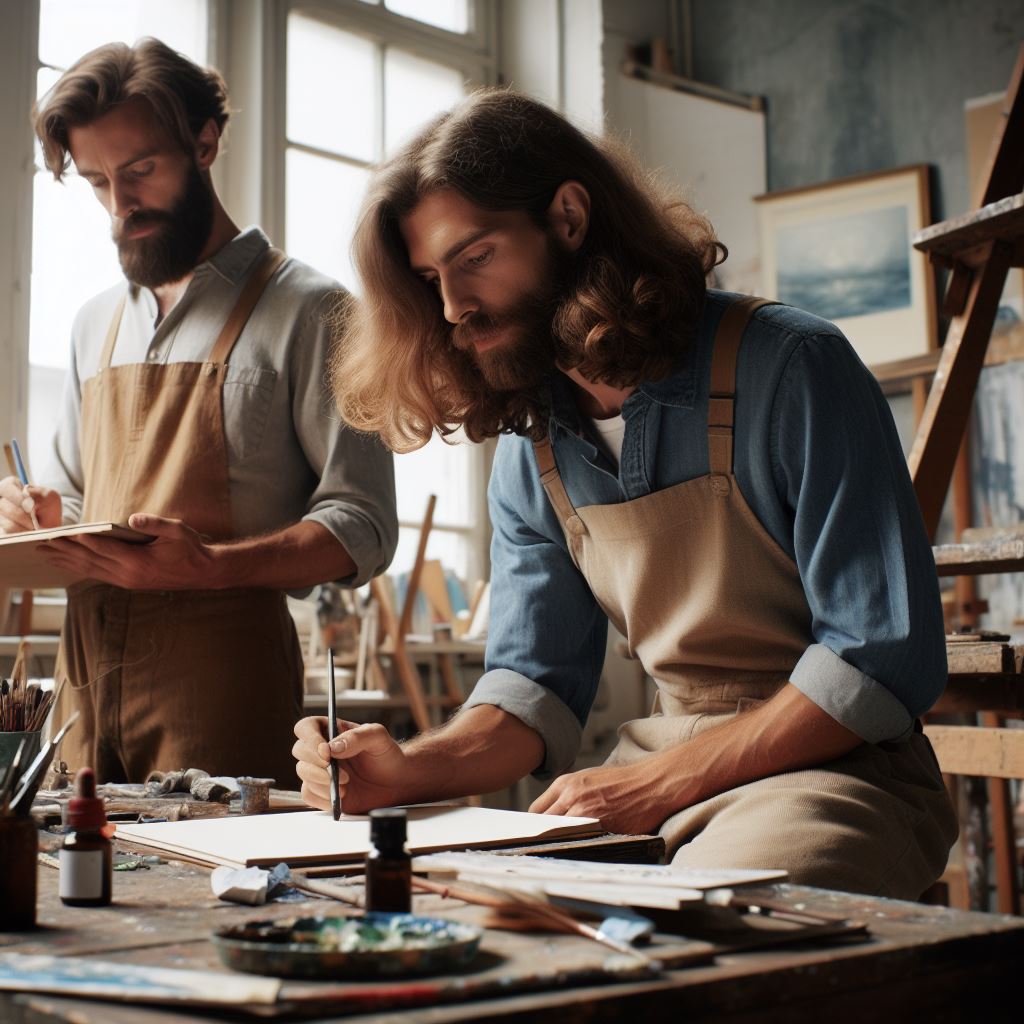Introduction
The UK art market is a highly competitive industry with great potential for artists seeking opportunities.
The UK art market plays a significant role in the global art scene, attracting collectors, dealers, and enthusiasts.
Artists who break into the UK art market can tap into a large and diverse audience, leading to increased visibility and potential sales.
Being a part of the UK art market allows artists to connect with renowned galleries, museums, and art institutions.
The UK art market also opens doors for artists to participate in prestigious art fairs and exhibitions.
Breaking into the UK art market can provide artists with networking opportunities, collaborations, and partnerships.
The market offers various avenues for artists to showcase their work, including solo shows, group exhibitions, and artist residencies.
The UK art market’s vibrant and dynamic nature allows artists to experiment with different styles, mediums, and concepts.
Artists breaking into the UK art market can gain recognition and credibility within the art community.
Exposure in the UK art market can lead to international recognition and expand an artist’s career beyond borders.
Understanding the UK Art Market
The UK art market is a vibrant and dynamic industry that offers numerous opportunities for artists to showcase their talents and gain recognition.
This section provides an overview of the UK art market, discusses popular art genres and key players, and highlights the challenges and competition artists may face.
An Overview of the UK Art Market
The UK art market is known for its diversity and rich cultural heritage. It encompasses various art forms, including painting, sculpture, photography, and mixed media.
With a thriving art scene, the UK attracts both local and international artists, collectors, and enthusiasts.
Types of Art That are Popular and in Demand
In the UK, there is a strong demand for contemporary art, which reflects the current cultural and social landscapes.
Modern and abstract art styles are particularly popular, with collectors seeking unique and innovative pieces.
Traditional art forms, such as landscape paintings and portraits, also have a dedicated market.
Key Players in the UK Art Market
The UK art market comprises several key players who contribute to its growth and success.
Galleries play a crucial role in promoting and exhibiting artists’ works.
They provide a platform for showcasing art to potential buyers and often act as intermediaries in sales transactions.
Well-established galleries have a wide network, enabling artists to reach a broader audience.
Auction houses have a significant impact on the UK art market as well.
They organize regular auctions where art collectors bid on valuable and rare artworks.
These auctions not only generate substantial sales but also establish market value and trends.
For artists, auction houses provide an opportunity for their works to gain recognition and fetch higher prices.
Art fairs are another essential aspect of the UK art market.
These events bring together artists, dealers, collectors, and enthusiasts from around the world.
Art fairs showcase a wide range of artworks, attracting both established and emerging artists.
Participating in art fairs allows artists to network, gain exposure, and potentially secure sales or commissions.
Challenges and Competition for Artists
While the UK art market offers numerous opportunities, artists also face various challenges and fierce competition.
The market is saturated with talented artists, making it crucial for newcomers to establish their unique style and brand.
Building a reputation and gaining recognition takes time, persistence, and consistent artistic development.
Artists may struggle to find representation by galleries or secure exhibition opportunities initially.
However, leveraging online platforms and social media can help overcome these challenges.
Artists can create an online presence, showcase their work, and connect with potential buyers directly, bypassing the traditional gallery system.
Furthermore, artists need to stay informed about market trends and collector preferences to ensure their work remains relevant.
Engaging with the art community, attending exhibitions, and participating in art competitions and residencies can help artists expand their network and gain exposure.
Basically, the UK art market offers a wealth of opportunities for artists.
Understanding the market’s dynamics, popular art genres, and key players is essential for artists looking to navigate and succeed in this competitive industry.
By adapting to evolving trends, building connections, and leveraging online platforms, artists can break into the UK art market and thrive.
Personalized UK Career Consulting
Receive tailored career guidance designed just for you. Get actionable steps and expert support to boost your career in 1-3 days. Take control of your career now.
Get StartedBuilding Your Artistic Identity
The importance of developing a unique artistic style and voice
Developing a unique artistic style is crucial when breaking into the UK art market. By standing out from the crowd, you increase your chances of gaining recognition and success.
One way to emphasize your artistic style is to showcase your best work in a strong portfolio. Select pieces that highlight your strengths and demonstrate your versatility as an artist.
The significance of a strong portfolio showcasing your best work
When creating your portfolio, it is essential to curate a collection that tells a cohesive story and reflects your unique artistic voice.
This helps potential buyers and galleries understand your vision and connect with your work.
In addition to a strong portfolio, an impressive artist statement and biography can help solidify your artistic identity.
These written pieces provide a deeper insight into your inspirations, motivations, and artistic process.
When crafting your artist statement, be clear and concise. Focus on your artistic intentions and what sets you apart from other artists.
It’s your chance to explain to viewers what they can expect from your work and why it matters.
Tips on how to create an impressive artist statement and biography
A well-written biography is equally important as it helps potential buyers and collectors understand your background and journey as an artist.
Highlight your accomplishments, education, exhibitions, and any relevant experiences that contribute to your artistic identity.
The value of networking and building relationships within the art community
Networking and building relationships within the art community is also crucial. Attend gallery openings, art fairs, and other art-related events to connect with fellow artists, curators, and potential buyers.
Social media platforms like Instagram and Facebook are excellent tools for networking.
Share your work regularly, engage with other artists’ posts, and participate in online discussions to expand your reach and visibility.
Collaborating with other artists can also help build your artistic identity.
Consider joining art collectives, participating in group exhibitions, or collaborating on projects that align with your artistic vision.
Another valuable networking tool is joining professional art organizations and associations.
These groups provide opportunities for workshops, exhibitions, and networking events where you can connect with art industry professionals and enthusiasts.
Your Dream Job Starts with a Perfect CV
Get a tailored CV and cover letter that captures your unique strengths and stands out in your industry. Let us help you make an unforgettable first impression.
Get StartedBuilding your artistic identity is an ongoing process. Continuously develop your skills, experiment with new techniques, and seek feedback from trusted mentors and peers.
Remember, authenticity is key. Stay true to your artistic vision and voice, and with perseverance and dedication, you can break into the UK art market and achieve recognition for your unique artistic style.
Build your artistic identity, showcase your best work, create a compelling artist statement, and connect with the art community to break into the UK art market.
Read: Corporate Ethics: A Guide for UK Directors
Finding Opportunities
As an artist looking to break into the UK art market, it is crucial to explore various avenues to showcase your work.
Here are some ways to find opportunities and gain recognition for your art:
Galleries
Galleries provide a traditional and prestigious platform for artists to exhibit their work. Approach galleries that align with your artistic style and research their submission guidelines.
Benefits
- Galleries offer a physical space dedicated to art, allowing viewers to fully experience your work.
- Networking opportunities with art collectors, curators, and other artists present at gallery events.
Drawbacks
- Competition is fierce, and it can be challenging to secure a spot in a well-established gallery.
- Some galleries charge artists for display space, reducing potential profits.
Tips for Approaching Galleries
- Prepare a professional portfolio showcasing your best work.
- Craft a concise artist statement explaining your artistic vision and message.
- Personalize your approach by researching the gallery’s past exhibitions and curatorial focus.
Art Fairs
Art fairs are bustling events where galleries, collectors, and art enthusiasts gather to explore and purchase art.
Participating in an art fair can provide excellent exposure for emerging artists.
Benefits
- Art fairs attract a diverse audience, including international collectors and art professionals.
- The chance to showcase your work alongside established artists, gaining credibility.
Drawbacks
- Costs associated with booth rental, logistics, and transportation can be high, especially for newcomers.
- The sheer volume of artwork on display may make it challenging to stand out.
Tips for Art Fair Success
- Apply to fairs that cater to your target audience and artistic style.
- Create a visually appealing booth that captivates viewers and reflects your artistic identity.
- Engage with visitors and potential buyers, sharing insights into your artwork.
Online Platforms
In the digital era, online platforms offer artists instant access to a global audience. Websites, social media, and online galleries can help artists gain exposure and sell their work.
Benefits
- Easy and affordable way to reach a wide range of art enthusiasts, including international buyers.
- Complete control over showcasing and pricing your artwork.
Drawbacks
- Online platforms lack the sensory experience of viewing art in person.
- The immense number of artists selling their work online makes it challenging to stand out.
Tips for Online Success
- Build a professional website or use specialized art platforms that allow you to curate and present your work effectively.
- Utilize social media platforms like Instagram and Facebook to share your creative process and engage with an online community.
- Take high-quality photographs of your artwork to accurately represent its colors, textures, and details.
Art Competitions and Grants
Participating in art competitions and applying for grants can provide funding opportunities and exposure to a wider audience.
Benefits
- Winning or being shortlisted in prestigious competitions can significantly boost your artistic career.
- Grants offer financial support for creating new work, organizing exhibitions, or pursuing art-related projects.
Drawbacks
- The competition pool is often vast, making it challenging to stand out.
- Some competitions and grants may have specific criteria or themes that limit artistic freedom.
Tips for Art Competitions and Grants
- Research and select competitions and grants that align with your objectives and artistic style.
- Pay attention to submission guidelines and thematic requirements to increase your chances of success.
- Submit a well-curated portfolio that demonstrates your artistic skills and unique perspective.
Finding opportunities to showcase your work in the UK art market requires perseverance, research, and effective self-promotion.
Exploring galleries, art fairs, online platforms, competitions, and grants can enhance your visibility and progression as an artist.
Remember to adapt your approach based on your artistic goals and the target audience you wish to connect with.
Read: Managing Change: A UK Director’s Toolkit

Pricing and Selling Your Artwork
When it comes to entering the UK art market, pricing and selling your artwork is of utmost importance. In this section.
We will explore the factors to consider when pricing your artwork and discuss various methods of selling your pieces.
Factors to Consider when Pricing Artwork
- Size: The size of your artwork plays a crucial role in determining its price. Larger pieces often command higher prices due to the higher material and production costs involved.
- Medium: The medium used in creating your artwork also affects its pricing. Certain mediums, such as oil or acrylic paints, may be more expensive than others, influencing the overall value of the piece.
- Market Demand: Understanding the demand for your artwork in the market is vital. If your work is highly sought after, you may be able to set higher prices due to the high demand and limited availability.
Various Methods of Selling Artwork
Once you have determined the right price for your artwork, you need to explore different avenues for selling it. Here are some popular methods:
Optimize Your LinkedIn for Success
Boost your LinkedIn profile with a professional bio, keyword-rich headline, and strategic recommendations that attract recruiters. Stand out from the crowd and get noticed.
Optimize Now- Galleries: Art galleries provide an excellent platform to showcase and sell your artwork. They have existing networks and clientele who are interested in purchasing artwork from emerging artists.
- Online Platforms: Utilizing online platforms like art marketplaces and social media can greatly expand your reach. These platforms allow you to connect with a global audience and sell directly to buyers.
- Art Auctions: Participating in art auctions can be a thrilling way to sell your artwork. Auction houses attract serious art collectors and investors who are willing to pay premium prices for exceptional pieces.
Effective Marketing and Promotion
To sell your artwork successfully, effective marketing and promotion are essential. Consider the following tips:
- Art Exhibitions: Participate in art exhibitions and shows to gain exposure and connect with potential buyers. These events allow you to showcase your work to a targeted audience interested in art.
- Networking: Building a strong network of art enthusiasts, collectors, and industry professionals can open doors to selling opportunities. Attend art events, join artist associations, and engage with the art community in-person and online.
- Social Media: Harness the power of social media platforms to promote your artwork. Regularly share high-quality images of your pieces, interact with followers, and collaborate with influencers to expand your online presence.
The Importance of Building a Professional Website or Online Portfolio
In the digital age, having a professional website or online portfolio is crucial for artists. Here’s why:
- Showcase Your Work: Your website acts as a digital gallery, allowing potential buyers to view and appreciate your artwork from the comfort of their homes.
- Build Trust: A well-designed website or online portfolio showcases your professionalism and dedication as an artist, instilling confidence in potential buyers.
- Direct Sales: With a website, you can sell your artwork directly to buyers without relying on intermediaries, keeping a larger portion of the revenue for yourself.
Remember, pricing and selling your artwork is a dynamic process. Continuously evaluate market trends, adapt your strategies, and engage with potential buyers to find success in the UK art market.
Read: Crisis Management Strategies for UK Directors
Navigating the Art Market
The importance of staying informed about the latest trends and developments in the art market
Staying informed about the latest trends and developments in the art market is crucial for artists looking to break into the UK art scene.
By keeping up with what’s happening, artists can position themselves strategically and make informed decisions about their career.
One of the essential tools in gaining exposure and connecting with potential buyers is social media.
Platforms like Instagram, Facebook, and Twitter provide artists with a global audience and an opportunity to showcase their work to a much larger market.
Artists can use these platforms to build a following, interact with potential buyers, and create a personal brand.
The role of social media in gaining exposure and connecting with potential buyers
To effectively use social media, artists should focus on creating high-quality content that reflects their unique style and vision.
Sharing behind-the-scenes glimpses into their creative process can help build a connection with their audience.
Artists should also engage with their followers, respond to comments, and show appreciation for their support.
By actively participating in social media conversations, artists can establish themselves as active and engaged members of the art community.
Tips on how to effectively use social media platforms to showcase and sell artwork
Using social media as a sales platform requires a strategic approach.
Artists should develop a consistent posting schedule to maintain a presence and keep followers engaged.
They should also utilize appropriate hashtags and keywords to reach a wider audience.
Additionally, collaborating with influencers or art-related accounts can help increase visibility and attract potential buyers.
While social media is a powerful tool, artists should not overlook the importance of physical galleries and art professionals.
Collaborating with galleries can provide exposure and credibility.
Artists should research galleries that align with their style and approach them with a clear and professional portfolio.
Building relationships with collectors, curators, and other art professionals is also crucial for networking and expanding opportunities.
Advice on how to negotiate and collaborate with galleries, collectors, and other art professionals
When negotiating with galleries, artists should be prepared and confident in discussing their work’s value and pricing.
Understanding market trends and having a clear idea of comparable works can help justify pricing and negotiate fair terms.
Collaborating with galleries can also lead to exclusive shows, art fairs, and other opportunities to showcase artwork to a wider audience.
In addition to galleries, artists should actively seek out connections with collectors.
Attending art events, networking, and engaging with collectors can lead to potential sales and further exposure.
Building lasting relationships and providing excellent customer service are essential for repeat sales and positive word-of-mouth recommendations.
To summarize, breaking into the UK art market requires artists to stay informed about the latest trends, actively use social media to gain exposure.
Collaborate with galleries and art professionals, and effectively negotiate sales.
By adopting a strategic approach and utilizing various platforms and networks, artists can navigate the art market successfully and build a thriving career.
Read: The Role of Non-Executive Directors in the UK
Conclusion
Breaking into the UK art market requires persistence and determination. Artists must continuously work on their craft, network with the right people, and find unique ways to stand out.
It may be a challenging journey, but success is possible with unwavering dedication. Aspiring artists should never give up on their dreams.
The art market can be competitive, but with passion and hard work, opportunities will arise.
It is essential to stay true to your style and convey your unique voice through your art. Remember, success may not come overnight, but every step counts.
Take advantage of the numerous online platforms and art communities available.
Build a strong online presence and showcase your work to a wider audience. Lastly, never underestimate the power of connecting with fellow artists and industry professionals.
Attend art events, exhibitions, and galleries. Collaborate with others, share ideas, and learn from their experiences.
The art world can be a tight-knit community, and building relationships can open doors to new opportunities.
Breaking into the UK art market is a journey that requires perseverance, patience, and a strong belief in oneself.
Keep striving, stay committed, and embrace any challenges that come your way.
With dedication and determination, success in the UK art market can be yours.
So, go forth, create, and make your mark in the vibrant art scene of the UK.
[E-Book for Sale]
500 Cutting-Edge Tech Startup Ideas for 2024 & 2025: Innovate, Create, Dominate
$19.99 • 500 Tech Startup Ideas • 62 pages
You will get inspired with 500 innovative tech startup ideas for 2024 and 2025, complete with concise descriptions to help you kickstart your entrepreneurial journey in AI, Blockchain, IoT, Fintech, and AR/VR.




